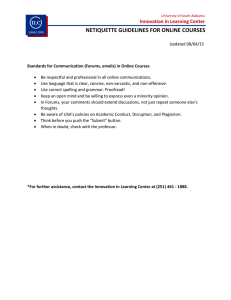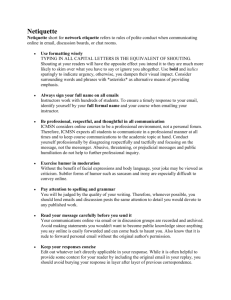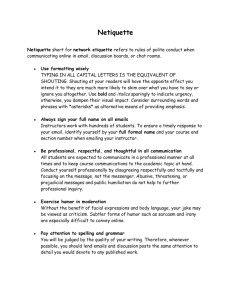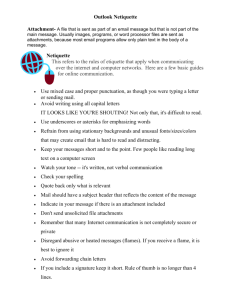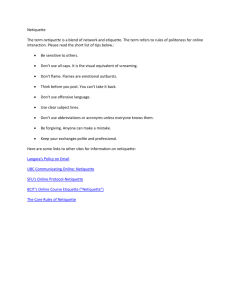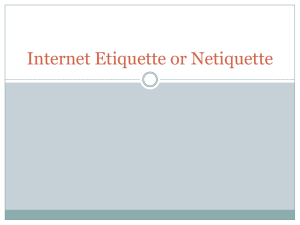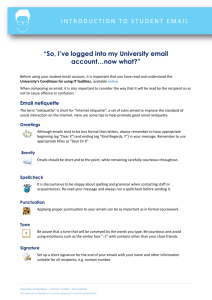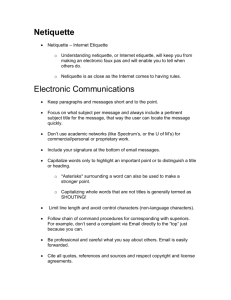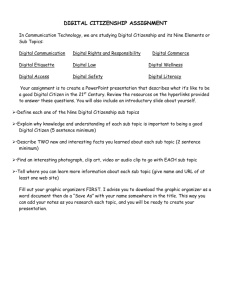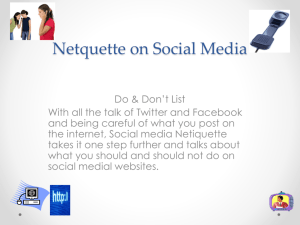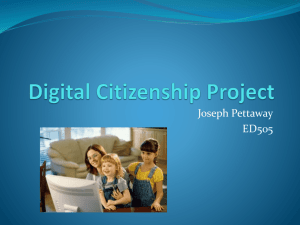ED508 Digital Citizenship Power Point Donna Rembert
advertisement
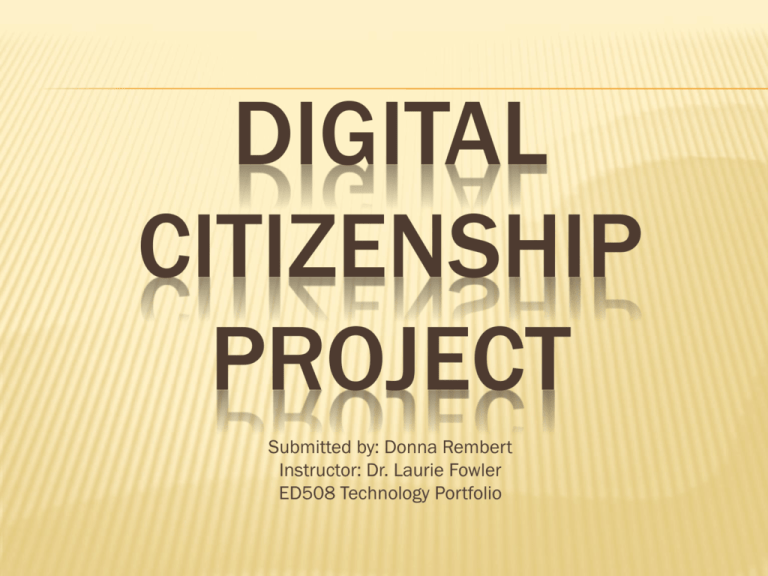
DIGITAL CITIZENSHIP PROJECT Submitted by: Donna Rembert Instructor: Dr. Laurie Fowler ED508 Technology Portfolio NETIQUETTE Netiquette is a cyber term for doing what is right on the internet. It is a combination of the words network and etiquette. It is how one behaves every time they hit the send button. There are over 2 billion users on the web NETIQUETTE RULES Only use your first name and personal information or pictures to anyone. Never agree to see someone you ‘meet” on line. Don’t believe everything you read. Some one may be using a false identity. Do not reply to messages that makes you feel uncomfortable. Let someone else know. Never give anyone your password. NETIQUETTE RULES Think before you post. Observe the site before you use it. Read the FAQ’s(frequently asked questions)and archives, before posting in group discussion or chat room. Use courtesy while using netiquette WHY DO WE NEED RULES? To protect our digital reputation on and offline To avoid “Flame Wars” online To treat others the way we want to be treated For your protection NETIQUETTE DO’S & DON’TS FOR EMAILS There are over 107trillion emails sent daily Make sure you use grammar & spell check Make sure your use your signature to let them know who is sending the email Don’t correct someone else’s spelling Don’t send emails when you are upset, angry or late at night Don’t use all caps in emails (it means you are yelling) ESSENTIAL NETIQUETTE TIPS FOR MOBILE PHONE USE Do not text while driving. No text is worth dying for. It is not safe to text while walking. Avoid playing texting games( some people are really busy and can’t always respond ASAP) Don’t lay phone on the dinner table or in a meeting. Keep conversations quiet while in public. COPYRIGHT AND FAIR USE Copyright – Allows only the person who has designed the work to edit, copy and benefit from it. Fair Use- Allows a person to use copyright materials without the owner’s permission COMPARING COPYRIGHT TO FAIR USE The difference between copyright and fair use is that there is no set limits for the person with copyrights and there are rules for fair use When making a copy one must consider: How will the copied materials be used? What is the purpose for copying? How much of the materials copied will be used? FAIR USE RULES FOR THE MEDIA Media materials can only be used for non-profit or educational purposes. Copied materials can be used or changed in order to entertain a large audience. PLAGIARISM Using someone’s ideas and claiming them to be yours. How to Avoid Plagiarism? Use quotations or reword or paraphrase Plagiarism Identified Google Search Programs for Plagiarism SAFETY ON THE INTERNET Identity Theft: Using another's private information for financial gain. Reputation Management: Being mindful of ones reputation on and off the internet. Password: Secret words or digits used to give one access to files and websites. Cyber bullying- Using the internet to ruin one’s reputation or harassing an individual. Cyber stalking: is stalking on the internet. SAFETY ON YOUR COMPUTER Virus: A virus on the computer attached itself to files on your computer and destroys it. Trojan Horses: A software that poses as one thing and only steals your information on your computer. :Worms: Send copies of itself to cause harm to the network or damage files on the computer SAFETY QUIZES ONLINE http://www.safekids.com/quiz/index.html http://www.chipublib.org/008subject/003cyn/ sign/safety.html WORK CITED Google. Web 06 June 2012 http://google.com http://www.plagiarism.org/plag_article_educational_tips_on_plagiarism_pr evention.html The Riles of Netiquette Web. 10 June 2012 http://smallbusiness.findlaw.com/copyright/copyright-using/fair-use.html http://wiki.ask.com/Cyberstalking http://www.networkequette.net/netiquettehtm. http://www.myreputationmanager.com/online_reputation_management_se m.html http://www.parentfurther.com/high-risk-behaviors/bullying/cyberbullying
